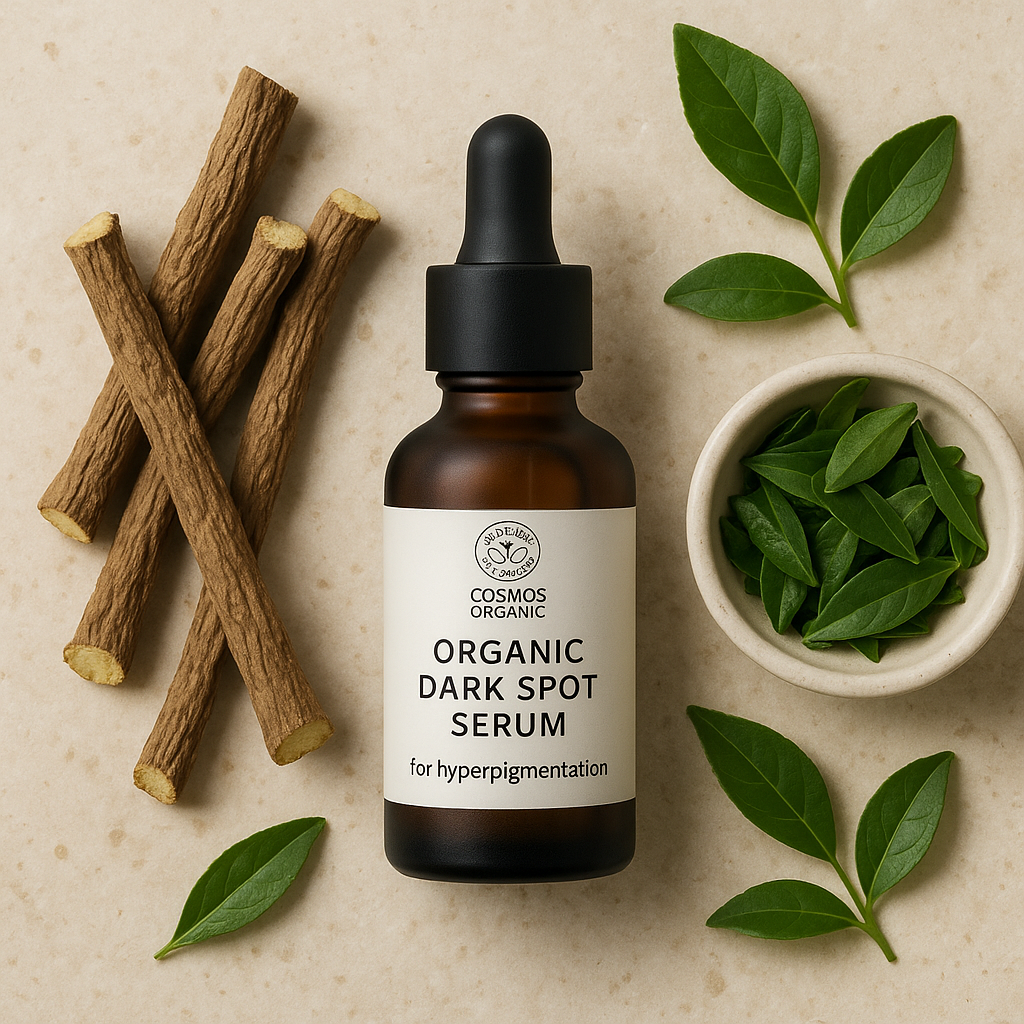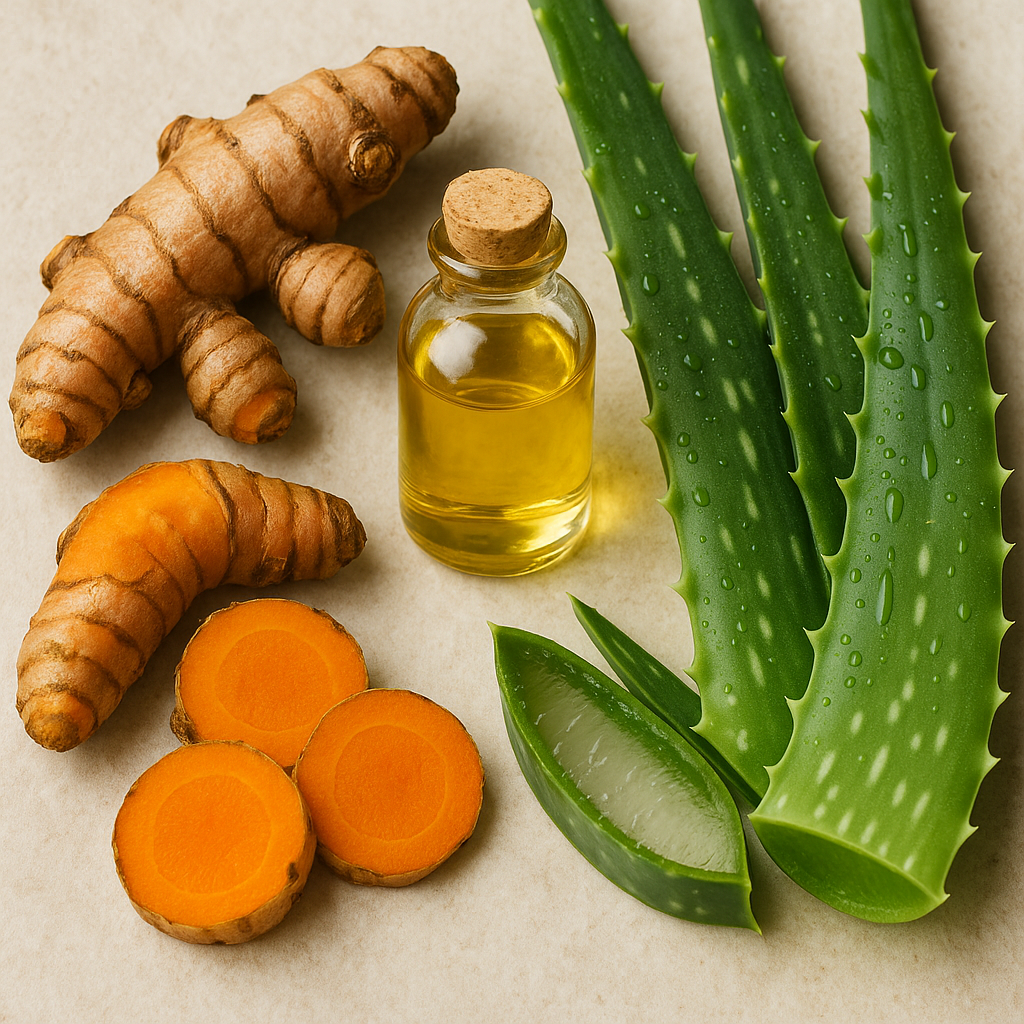
An Organic Dark Spot Routine for Hyperpigmentation: Gentle, Effective, and Sustainable
Share
Dark spots and hyperpigmentation are common skin concerns experienced by many across all skin types.
But what exactly causes these stubborn marks, and how can an organic dark spot routine help resolve them?
This comprehensive guide unveils everything you need to master an organic dark spot routine for hyperpigmentation, tailored for sensitive, eco-conscious skin.
Some are caused by sun exposure that triggers excess melanin production.
Some form after acne, known as post-inflammatory hyperpigmentation.
Some are stubborn age spots that reflect years of skin history.
Some require gentle ingredients that soothe as much as they correct.
Some demand sustainable and cruelty-free skincare choices without compromise.
Let's dive right in.
What Is Hyperpigmentation and Why Does It Form?
Hyperpigmentation refers to darkened patches or spots on the skin, resulting from excess melanin, the pigment responsible for colour.
There are several forms including melasma (hormone-related patches), post-inflammatory hyperpigmentation (often following acne or injury), and solar lentigos or age spots (sun-induced).
At a molecular level, hyperpigmentation involves three key steps:
- Excess melanin production by pigment cells (melanocytes) via an enzyme called tyrosinase.
- Transfer of this pigment to skin cells (keratinocytes).
- Deposition and stubborn retention of melanin within these skin cells.
Sun exposure, hormonal changes, and inflammation are primary triggers for hyperactive melanocytes that lead to these uneven skin patches.
Understanding this cycle guides the choice of effective, targeted skincare ingredients and routines.
Why Choose an Organic Dark Spot Routine for Hyperpigmentation?
Organic skincare routines offer distinct benefits especially for those with sensitive or reactive skin prone to pigmentation irregularities.
LULUMINE’s range focuses on COSMOS certified organic formulas that are 90%+ natural origin, vegan, and cruelty-free — prioritising skin health and environmental sustainability.
The gentle, science-backed botanicals used in organic treatments help inhibit melanin production and soothe inflammation without the irritation often linked to synthetic actives.
For instance, green tea polyphenols are powerful antioxidants and have been clinically shown to reduce pigment formation and protect against photo-damage (source).
Moreover, organic does not mean less effective; carefully formulated serums can harness potent natural brighteners like daisy extract, licorice root, or turmeric to fade dark spots and improve skin texture.
Choosing an organic dark spot routine aligns with mindful skincare values — promoting self-love, environmental care, and conscious consumerism simultaneously.
How to Build an Effective Organic Dark Spot Routine for Hyperpigmentation
A robust dark spot routine works across all hyperpigmentation stages — controlling pigment production, blocking transfer, and accelerating existing pigment removal.
Below are the essential steps, each with focused organic or gentle ingredients to help you create your ideal regimen.
1. Cleanse Gently But Thoroughly
A clean canvas ensures all treatments work efficiently.
Use a gentle organic cleanser free from harsh sulphates or fragrance to avoid irritation that can worsen pigmentation.
Look for hydrating ingredients like aloe vera or oat extract that calm sensitive skin while removing impurities.
For guidance on soothing cleansers, check our Choosing the Perfect Gentle Vegan Facial Cleanser guide.
2. Protect with Broad-Spectrum Organic Sunscreen
Sunscreen is the cornerstone to prevent existing dark spots from deepening and new ones forming.
A tinted organic sunscreen blocks both UV and visible light, the latter of which also triggers melanocytes.
Consistent use of an SPF 30 or higher sunscreen is non-negotiable in any hyperpigmentation routine (Verified with sources as of 2025-09-14).
Opt for mineral-based formulas with zinc oxide that are gentle on sensitive skin and environmentally friendly.
3. Target Pigment Production with Organic Brightening Ingredients
Ingredients like organic vitamin C (ascorbic acid), alpha-arbutin (plant-derived), licorice root extract, and niacinamide inhibit tyrosinase and melanin synthesis.
Vitamin C is a potent antioxidant that not only brightens but protects skin from environmental damage.
Niacinamide also reduces pigment transfer between cells and calms inflammation, essential for sensitive or reactive skin types (source).
These actives are often best delivered in serums that absorb quickly without overwhelming the skin.
4. Boost Cell Turnover with Gentle Exfoliation
Removing pigment already deposited in the skin requires gentle exfoliation to speed up skin renewal.
Organic alpha hydroxy acids (AHAs) like mandelic or lactic acid gently dissolve dead skin cells and lighten dark spots without aggressive irritation.
They should be introduced slowly, ideally at night and not on the same days as potent retinol treatments to avoid increased sensitivity.
5. Use Retinoids for Enhanced Pigment Removal and Skin Repair
Retinoids, including retinol and its derivatives, accelerate epidermal turnover and reduce pigment transfer.
Organic encapsulated retinol serums provide a gradual release that’s effective yet gentle, ideal for hyperpigmented sensitive skin (source).
Start with a few nights per week to build tolerance, pairing with soothing moisturizers to minimise irritation.
6. Nourish and Moisturize with Organic Hydrators
Moisturizing heals and fortifies the skin barrier, crucial when using active treatments that can cause dryness or sensitivity.
Look for fragrance-free, vegan moisturizers enriched with hyaluronic acid, ceramides, and botanical oils like jojoba or rosehip, which also support brightening.
For more, see our detailed guide on organic moisturizers for sensitive skin.
7. Consider Targeted Spot Treatments
Concentrated organic spot correctors often combine several brightening actives such as licorice root, turmeric, and green tea polyphenols to tackle stubborn pigment patches.
They are designed to be applied precisely on dark spots without irritating surrounding skin.
LULUMINE offers COSMOS certified options that synergistically soothe while brightening for lasting, natural results.
How Do I Apply an Organic Dark Spot Routine for Best Results?
The sequence and consistency of your routine often determine your success with hyperpigmentation.
Here is a simple ideal daily flow:
- Morning: cleanse > antioxidant serum (e.g., vitamin C or niacinamide) > organic tinted SPF sunscreen.
- Evening: cleanse > retinol serum > spot treatments on affected areas > moisturize.
- Two nights a week: replace retinol with gentle AHA exfoliant to promote pigment removal.
Patience is essential. Visible improvements typically take 4–12 weeks depending on pigmentation severity and skin type.
Tracking progress with photos and notes help you stay motivated.
Common Myths about Using Organic Skincare for Dark Spots
Some believe organic products are too mild for hyperpigmentation treatment — but with the right actives and formulation, they can be just as effective as synthetic options.
Others think natural means no adverse effects; however, irritation can still occur, especially if overused. Start slow and listen to your skin.
Many confuse organic with unsophisticated; in reality, organic skincare often involves advanced technology to stabilise potent natural ingredients for maximum efficacy.
Can I Accelerate Results with Supplemental Practices?
Yes. Complement your routine with lifestyle habits that support skin health.
Stay hydrated, nourish your skin from within with antioxidant-rich foods (berries, leafy greens), and manage stress, which can worsen hormonal pigmentation.
In-office treatments such as gentle chemical peels or laser procedures may be considered in consultation with a dermatologist when combined with daily organic care.
What Ingredients Should I Avoid if I Have Sensitive Skin?
Harsh chemical peels, synthetic fragrances, parabens, and higher concentrations of potent acids or retinoids can aggravate sensitive skin and worsen pigmentation in the long term.
Always patch test new products and prefer COSMOS certified organic options tailored for sensitive skin to minimise risks.
How Do I Choose the Best Organic Dark Spot Serum?
Look for serums with scientifically supported actives such as:
- Alpha-arbutin: A gentle but effective tyrosinase inhibitor.
- Licorice root extract: Known for its anti-inflammatory and brightening properties.
- Niacinamide: Helps reduce pigment transfer and supports barrier health.
- Vitamin C: Antioxidant and melanin synthesis inhibitor.
- Green tea polyphenols: Powerful antioxidants with melanin blocking ability (source).
LULUMINE’s range includes such carefully selected ingredients in COSMOS certified, vegan, cruelty-free formulations made with sensitive skin in mind.
This expert guide video further unpacks causes, treatments, and routines for managing hyperpigmentation effectively without harsh chemicals or guesswork.
Why Is Consistency Key in Dark Spot Treatment?
Because hyperpigmentation develops and fades gradually, consistent application of your organic dark spot routine ensures continuous inhibition of pigment formation and accelerates renewal.
Intermittent use allows melanin to accumulate unchecked and reduces the cumulative benefits of treatment ingredients.
Establishing a simple, enjoyable ritual around your routine will help you stay dedicated and see lasting results.
Can I Use Organic Dark Spot Products with Other Skincare Actives?
Yes, but with care and knowledge.
Some actives like exfoliating acids or retinoids can increase irritation if layered improperly or overused.
Pairing organic brighteners with gentle antioxidants such as vitamin C or niacinamide can be synergistic.
Avoid mixing strong acids and retinoids on the same day to reduce sensitivity.
Consult product instructions and, if unsure, consider advice from skincare professionals.
How Do I Maintain Results After Dark Spot Correction?
Maintenance focuses on ongoing sun protection, gentle skincare, and avoiding triggers such as excessive sun exposure and skin irritation.
Incorporate antioxidant-rich moisturizers to nourish the skin’s barrier and keep tone even.
Using LULUMINE’s sustainably packaged, fragrance-free products can promote skin health while aligning with conscious beauty values (source).
Can Organic Remedies Be Used alongside Clinical Treatments?
Indeed, integrating thoughtful organic care before and after clinical procedures like chemical peels or lasers supports healing, reduces inflammation, and prolongs results.
However, always discuss with your medical provider and adjust your skincare routine around treatments to minimize irritation.
Frequently Asked Questions about Organic Dark Spot Routine
- How soon can I expect to see results?
- Typically within 4 to 12 weeks with consistent use, though some see improvements earlier depending on skin type and pigmentation severity.
- Is vitamin C safe for sensitive skin?
- Yes, especially in stable, organic formulations with moderate concentrations. Start slowly to build tolerance.
- Can I use organic dark spot products during pregnancy?
- Look for products free from retinoids and hydroquinone. Organic plant actives like licorice root are often safer but consult your healthcare provider.
- Do organic ingredients work as well as synthetic ones?
- When properly formulated, organic ingredients can be equally effective with added benefits of gentleness and sustainability.
- How important is sunscreen in my routine?
- Crucial. Without sun protection, treatments may fail, and existing dark spots can worsen (Verified with sources as of 2025-09-14).
Navigating Your Personal Organic Dark Spot Journey
Every skin’s response is unique. Document your progress, note product reactions, and adjust as needed.
Build rituals that honour self-care and gentle nurturing, remembering that improvement takes time.
Celebrate small wins: your skin telling stories of resilience, renewal, and radiant health.
What's Your Next Step?
Tell us in the comments: How will you apply this to your organic dark spot routine for hyperpigmentation? For personalized advice, explore our recommended night routine tailored for sensitive skin!
References
- Novexpert Target Care Spot Corrector – for green tea polyphenols and clinical insights on organic brightening.
- LULUMINE: Niacinamide Serum Benefits – effective and gentle ingredients for hyperpigmentation.
- COSMOS Certified Organic Skincare Benefits – safety and sustainability in gentle formulations.


